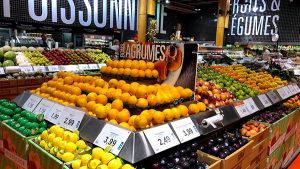Ecommerce has revolutionized the art of buying and selling over the past two decades—and now it’s poised to reshape the retail grocery sector.

The Food Marketing Institute and Nielsen expect fully 70 percent of consumers to be shopping online for groceries by 2024, and Brick Meets Click, a strategic advisory firm headquartered in Barrington, IL, forecasts a whopping 15 percent growth in U.S. online grocery sales in 2019 alone.
Online shopping is here to stay, as consumers look for more convenience in all facets of life, and this has come to include buying groceries.
As a result, food retailers all over North America have urgently invested in click-and-collect and home delivery to compete with Amazon and Walmart, which led the charge to win consumer loyalty in this consequential space.
With nearly 2,500 locations coast to coast and longstanding shopper loyalty, Canada’s largest grocery retailer, Loblaw Companies Limited (Loblaw), is well positioned to benefit from this mushrooming segment of the grocery market.
Although competitive pressures including Amazon’s Whole Foods deal seem to be limiting margin expansion in the grocery space (typically well under 5 percent), Loblaw has prioritized technological investments and already has the largest click-and-collect network in Canada.
So how will the new emphasis on online shopping impact produce sales at Loblaw?
For Ed Treacy, vice president of supply chain and sustainability for the Produce Marketing Association, the answer is pretty simple.
“You need to build trust right from the beginning,” he said, and ensure order pickers make quality choices. “Any produce that goes into a customer’s basket must be as good as they would have picked out themselves.”
For a company with the size and scope of Loblaw, this shouldn’t be a problem. Treacy considers Canada’s retail environment top notch, and competition keeps its leaders on their toes. “They’re very good retailers; they have great stores. Although in the United States there are more regional retailers, in Canada Loblaw operates nationally with just four other big players—Sobeys, Metro, Walmart, and Costco.
“Loblaw is number one for a reason,” Treacy said, adding that the company also has “the resources to continually invest in research and development, and has put a lot of money into technology.”
Part of this spending includes Loblaw’s home delivery partnership with Instacart, which continues to expand rapidly. Launched initially in Toronto and Vancouver in December 2017, it grew substantially last year, putting delivery within reach of nearly half of all Canadians.
Online orders from Loblaw and several of its other banners, including Real Canadian Superstores and T&T Supermarkets, can be delivered in as little as one hour. Users simply download the Instacart app and chose from up to 30,000 SKUs, selecting a delivery time window that works for them. For orders of $35 or more, the fee is just $3.99 for delivery.
Another ecommerce play, PC Express, allows Loblaw customers in the Toronto area to pick up groceries at selected public transportation stops on their way home from work, provided they place their orders by midnight the night before.
This is an excerpt from the most recent Produce Blueprints quarterly journal. Click here to read the full supplement.


